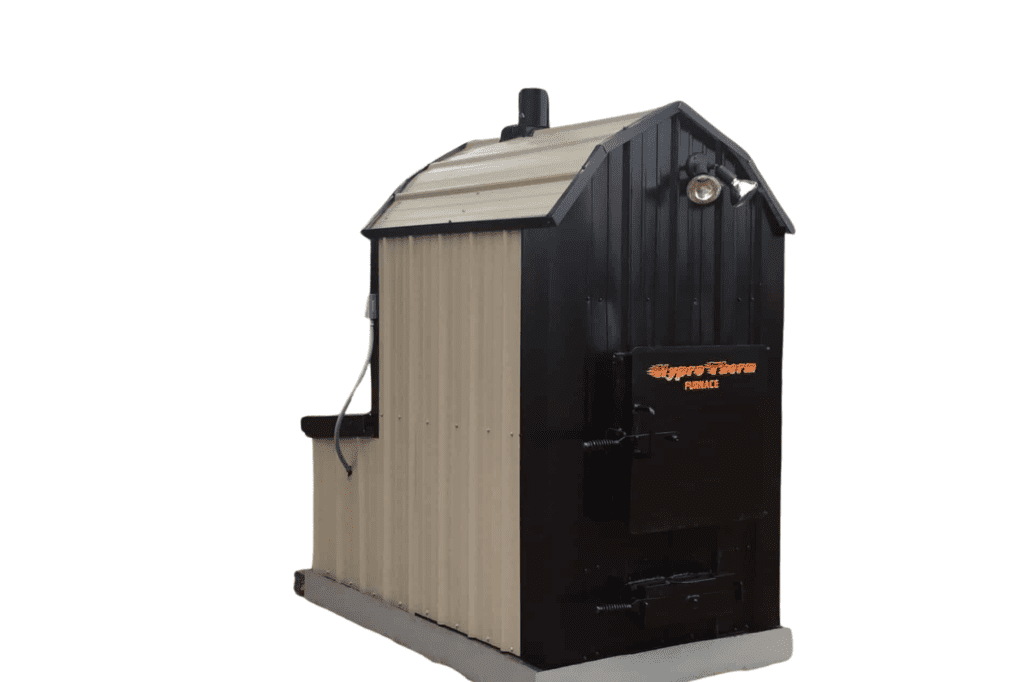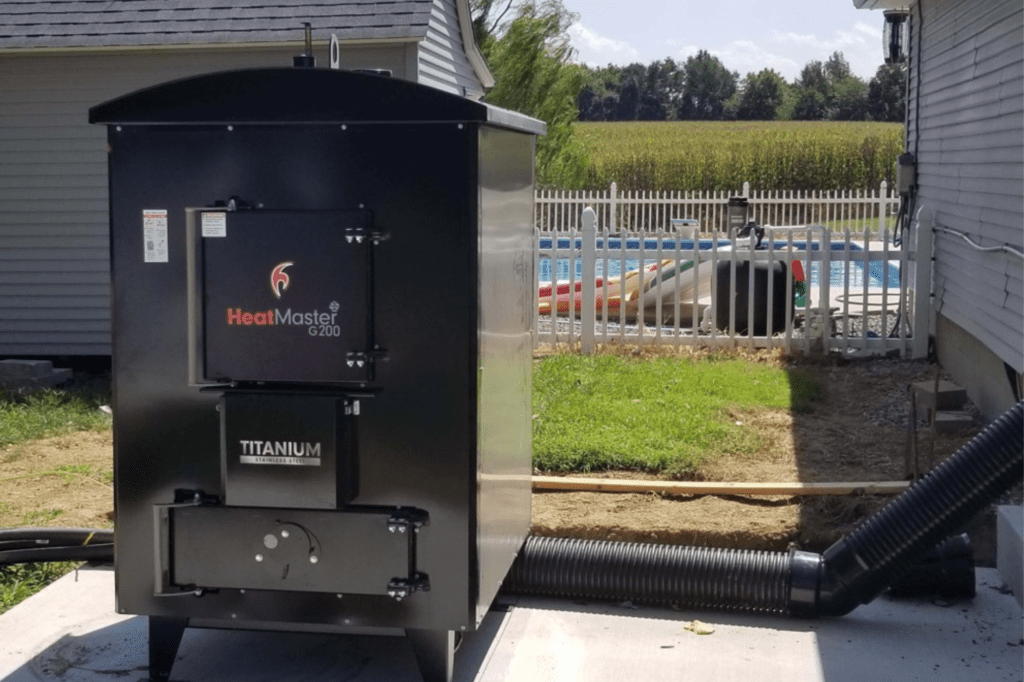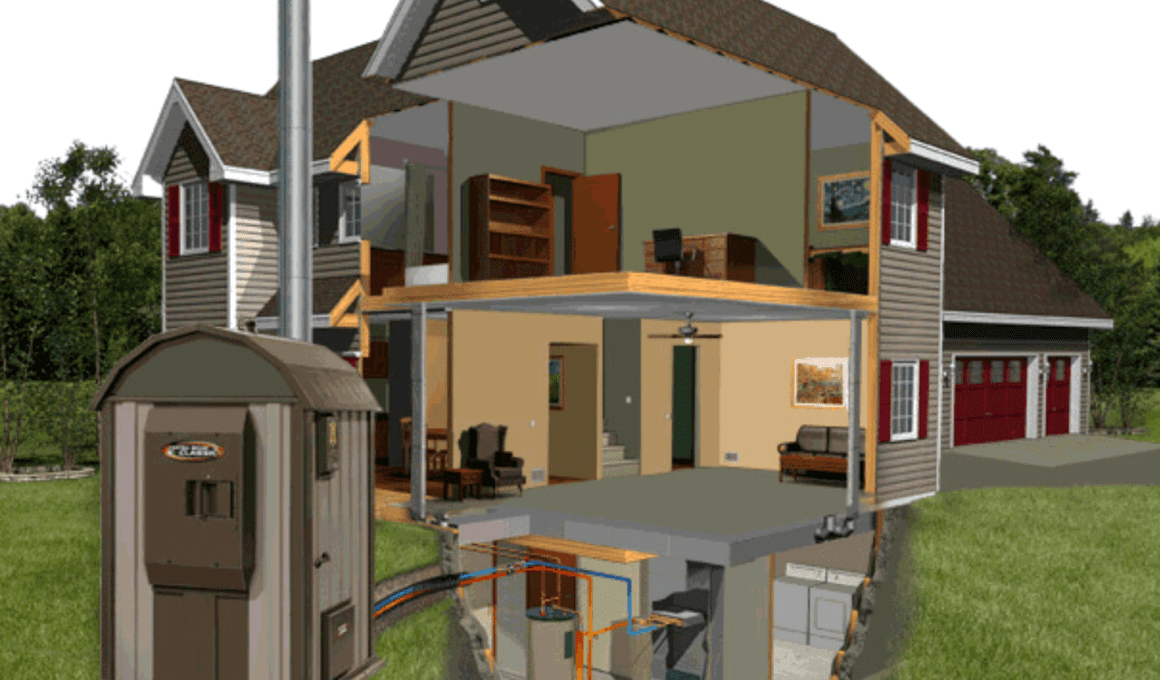Quick Summary
- Outdoor wood furnaces are efficient heating systems that burn wood to produce heat, which is then transferred to the home through a heat transfer mechanism.
- They can use wood pellets and coal as fuel, with wood pellets being made from compressed sawdust and burning cleanly, while coal provides long-lasting and high heat output.
- Advancements in heating technology, such as improved insulation, advanced combustion systems, and control panels, contribute to optimal warmth and efficiency.
- Outdoor wood furnaces have environmental implications, including the release of carbon dioxide and particulate matter, but proper maintenance and operation can minimize their environmental impact.
Combustion Process
You’ll love watching the outdoor wood furnace come to life as it ignites the wood and transforms it into a powerful source of heat through a mesmerizing combustion process. Safety is always a top priority when it comes to operating an outdoor wood furnace, so let’s dive into how it works while keeping safety in mind. The combustion process begins with the proper air supply. The furnace is equipped with an air intake system that allows for the perfect amount of oxygen to enter the combustion chamber. This is crucial for efficient burning and preventing the release of harmful gases. Once the wood is loaded into the furnace, the combustion chamber is ignited. The wood is set ablaze, creating a controlled fire. As the fire burns, it generates intense heat, which is then transferred to the water or air that circulates through the furnace’s heat exchanger. The mesmerizing part of the combustion process is watching the flames dance and the wood gradually turning into embers. The combustion chamber is designed to maximize heat transfer and minimize emissions, ensuring that the furnace operates safely and efficiently. Remember, safety precautions should always be followed when operating an outdoor wood furnace. Regular maintenance, proper loading techniques, and monitoring the combustion process are essential to ensure safe and efficient operation. Enjoy the warmth and cozy atmosphere that an outdoor wood furnace provides, knowing that it’s working safely and effectively to keep you comfortable.Heat Transfer Mechanism
To understand the heat transfer mechanism of an outdoor wood furnace, you’ll need to grasp the intricate process by which thermal energy is efficiently transferred from the burning wood to the surrounding air or water. This transfer occurs through two main mechanisms: radiation and convection. Radiation is the primary mechanism by which heat is transferred in an outdoor wood furnace. As the wood burns, it releases infrared radiation, which is a form of electromagnetic radiation. This radiation travels in straight lines and is absorbed by the surrounding air or water, causing it to heat up. This is why you’ll often see flames and glowing embers in a wood furnace – it’s the result of the radiation mechanism at work. Convection is another important mechanism in the heat transfer process. As the air or water near the wood furnace heats up, it becomes less dense and rises, creating a convection current. This hot air or water then circulates around the furnace, carrying the thermal energy away from the burning wood and distributing it throughout the space. This convection mechanism helps to ensure that the heat is evenly distributed and that the entire area is warmed effectively. Understanding these heat transfer mechanisms is crucial for operating an outdoor wood furnace safely and efficiently. By maximizing the radiation and convection processes, you can ensure that your furnace operates at its full potential and provides the desired warmth to your outdoor space.Types of Fuel Used
If you’re looking for a cozy and convenient way to warm your outdoor space, consider the different types of fuel options available for your heating needs. When it comes to outdoor wood furnaces, there are primarily two types of fuel used: wood pellets and coal.- Wood pellets: These are a popular choice for outdoor wood furnaces due to their efficiency and convenience. Wood pellets are made from compressed sawdust and other wood waste materials. They burn cleanly and produce a consistent heat output. Plus, they’re easy to handle and store. However, it’s important to ensure that the wood pellets you use are of high quality and free from contaminants to maintain the efficiency and safety of your outdoor wood furnace.
- Coal: Another option for fueling your outdoor wood furnace is coal. Coal is a traditional fuel source that’s been used for heating purposes for many years. It provides a long-lasting and high heat output, making it suitable for colder climates. However, it’s essential to handle and store coal properly to prevent any safety hazards. Make sure to follow the manufacturer’s guidelines and use coal that’s suitable for your specific outdoor wood furnace.
Heating Capacity and Efficiency
Achieving optimal warmth and efficiency is crucial when heating your outdoor space with different fuel options. When it comes to heating capacity and efficiency, outdoor wood furnaces have made significant advancements in heating technology. These advancements have allowed for more efficient and effective heating, resulting in a higher level of warmth and comfort for your outdoor space.
One of the main factors that contribute to the heating capacity of an outdoor wood furnace is the size and design of the combustion chamber. A larger combustion chamber allows for a greater amount of wood to be burned, resulting in a higher heat output. Additionally, outdoor wood furnaces have been designed with improved insulation, which helps to retain heat and prevent energy loss.
In terms of efficiency, outdoor wood furnaces have also made strides in utilizing renewable energy sources. Many models now feature advanced combustion systems that optimize the burning process, ensuring a cleaner and more efficient burn. This not only reduces emissions but also maximizes the heat generated from the wood.
Furthermore, outdoor wood furnaces can now be integrated with other heating systems, such as radiant floor heating or forced air systems. This allows for a more comprehensive heating solution and ensures that the warmth is distributed evenly throughout your outdoor space.
By taking advantage of these heating technology advancements and utilizing renewable energy sources, outdoor wood furnaces can provide both optimal warmth and efficiency for your outdoor space.
These advancements have allowed for more efficient and effective heating, resulting in a higher level of warmth and comfort for your outdoor space.
One of the main factors that contribute to the heating capacity of an outdoor wood furnace is the size and design of the combustion chamber. A larger combustion chamber allows for a greater amount of wood to be burned, resulting in a higher heat output. Additionally, outdoor wood furnaces have been designed with improved insulation, which helps to retain heat and prevent energy loss.
In terms of efficiency, outdoor wood furnaces have also made strides in utilizing renewable energy sources. Many models now feature advanced combustion systems that optimize the burning process, ensuring a cleaner and more efficient burn. This not only reduces emissions but also maximizes the heat generated from the wood.
Furthermore, outdoor wood furnaces can now be integrated with other heating systems, such as radiant floor heating or forced air systems. This allows for a more comprehensive heating solution and ensures that the warmth is distributed evenly throughout your outdoor space.
By taking advantage of these heating technology advancements and utilizing renewable energy sources, outdoor wood furnaces can provide both optimal warmth and efficiency for your outdoor space.
Operation and Control Systems
One of the key elements in operating and controlling an outdoor wood furnace is the user-friendly control panel, which allows for easy adjustments to temperature and settings. The control panel is designed with safety in mind, ensuring that you have full control over the operation and temperature regulation of your outdoor wood furnace. Here are four important features of the control panel that will help you operate your furnace safely and efficiently:
Here are four important features of the control panel that will help you operate your furnace safely and efficiently:
- Temperature Settings: The control panel allows you to set the desired temperature for your indoor heating. You can easily adjust the temperature according to your comfort level, ensuring that your home stays warm and cozy without overheating.
- Fan Speed Control: With the control panel, you can adjust the fan speed of your outdoor wood furnace. This feature allows you to optimize the airflow and ensure efficient combustion, resulting in better heat distribution and reduced emissions.
- Ash Removal Indicator: The control panel is equipped with an ash removal indicator that alerts you when it’s time to clean the ash from the furnace. Regular ash removal is essential for maintaining the efficiency and safety of your furnace.
- Safety Shutdown: The control panel also has a safety shutdown feature that automatically turns off the furnace in case of any malfunction or overheating. This ensures that your outdoor wood furnace operates within safe limits and minimizes the risk of accidents or damage to your property.
Can Wood Mulch Be Used in an Outdoor Wood Furnace?
Wood mulch is not suitable for an outdoor wood furnace. While it’s a convenient way of disposing of wood mulch, using it in a furnace can lead to numerous problems. The mulch tends to smolder and create excessive smoke, posing a fire hazard. Additionally, it can clog the system and cause damage, making it essential to avoid using wood mulch in outdoor wood furnaces.
Environmental Impact
To fully understand the impact on the environment, you must consider the emissions and air quality effects of operating an outdoor wood furnace. These furnaces are known for their efficiency in heating large areas, but they also have implications for climate change and air pollution. One of the main concerns with outdoor wood furnaces is the release of carbon dioxide (CO2) when wood is burned. CO2 is a greenhouse gas that contributes to climate change. However, compared to other fossil fuels, wood is considered a renewable resource, as trees can be replanted to offset the carbon emissions. Another environmental concern is the release of particulate matter and other pollutants into the air. These emissions can have negative effects on air quality and human health. It is important to ensure that the wood used in the furnace is properly seasoned and that the furnace is operated correctly to minimize emissions. To give you a better understanding of the environmental impact, here is a table summarizing the emissions and air quality effects of operating an outdoor wood furnace:| Environmental Impact | Description |
|---|---|
| Climate Change | CO2 emissions contribute to global warming. |
| Air Pollution | Particulate matter and other pollutants affect air quality. |
Maintenance and Safety Considerations
Ensure that you prioritize the safety of your loved ones by regularly maintaining and following proper safety protocols when using your outdoor wood furnace. Fire prevention should be a top concern when operating your wood furnace. To minimize the risk of fire, it’s crucial to keep the area around the furnace clear of any flammable materials such as leaves, paper, or firewood. Regularly inspect the chimney and flue pipe for any blockages or creosote buildup, as these can increase the chances of a chimney fire. Additionally, it’s important to properly dispose of ash from the furnace in a metal container and store it away from any combustible materials. Proper ventilation is essential for the safe operation of an outdoor wood furnace. Make sure that the furnace is installed in a well-ventilated area to prevent the buildup of carbon monoxide gas. Regularly check the air intake and exhaust vents to ensure they’re clear of any debris or obstructions. Also, consider installing carbon monoxide detectors near the furnace and inside your home to provide early warning in case of a gas leak. By taking these maintenance and safety considerations seriously, you can enjoy the warmth and cost-saving benefits of your outdoor wood furnace while keeping your loved ones safe from potential hazards.Cost and Energy Savings Potential
Maximize your savings and reduce your energy costs by taking advantage of the cost and energy savings potential offered by an outdoor wood furnace. Investing in an outdoor wood furnace can significantly improve the energy efficiency of your home and provide you with long-term cost savings. By using wood as a fuel source, you can reduce your reliance on expensive fossil fuels and decrease your carbon footprint. To help you understand the potential savings, let’s take a look at a comparison table:| Heating System | Initial Cost | Annual Fuel Cost | Payback Period |
|---|---|---|---|
| Outdoor Wood Furnace | $5,000-$15,000 | $500-$1,000 | 5-10 years |
| Propane Furnace | $2,500-$5,000 | $1,500-$3,000 | 1-3 years |
| Electric Heat Pump | $3,000-$7,000 | $1,500-$2,500 | 3-5 years |









